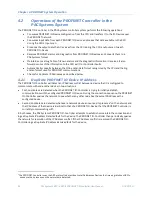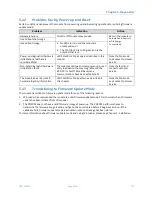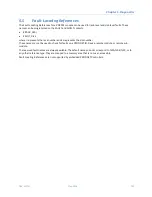
Chapter 4. PROFINET System Operation
GFK-2571N
May 2018
99
4.7.5
Scan Set I/O for Remote I/O Modules
The
Scan Set I/O
function of the PACSystems CPU requests the scanning of remote modules that are members
of a configured scan set. The
Scan Set I/O
function operates like a
DO I/O
function, with the added ability to
identify and group the modules to be scanned. Modules are grouped according to their configured scan sets. As
with the
DO I/O
function, the
Scan Set I/O
function updates/consumes data stored in the local PROFINET
Controller; it does not directly update IO-Devices in remote nodes.
4.7.6
PACSystems CPU Defaults - Inputs
The PACSystems CPU defaults input data from remote I/O modules under the following conditions:
•
the remote module or PROFINET Controller has not yet come online following a download of hardware
configuration
•
the remote module or PROFINET Controller has not yet come online following a power cycle
•
the remote module signals its input data is no longer valid (e.g. due to local module fault)
•
the remote module is extracted from the backplane
•
the remote module loses power or otherwise fails
•
the PROFINET Controller loses power or otherwise fails
•
the PROFINET network connection (Application Relationship) associated with the input data is lost.
The PACSystems CPU defaults the input values of an input module based on the input default state configured
for the I/O Device. Inputs may be configured to either Hold Last State or Force Off (zero).
If a PROFINET Controller loses connections to an I/O device, the following actions occur:
1.
The CPU defaults the input values of all input modules assigned to it within the IO-Device.
2.
The PROFINET Controller logs a
Loss of Device
fault in its Local Log
and in the CPU’s I/O
Fault Table.
3.
The I/O point fault contacts for the I/O references and variables associated with the IO-Device are set to
the faulted state (if point faults are enabled on the CPU).
4.7.7
PACSystems CPU Defaults - Outputs
Outputs default when the CPU is no longer providing the data (e.g. when CPU has I/O disabled). For I/O
modules which control their own output defaults based on their configuration, the output behavior is
determined by that configuration setting. For I/O modules which do not have such a configuration setting, the
output default behavior is fixed (typically 0). Refer to the specification for each I/O module type to determine
behavior.
















































